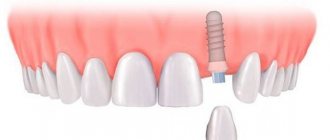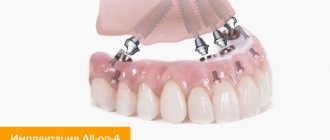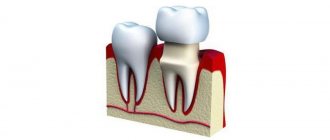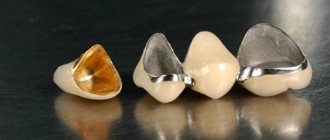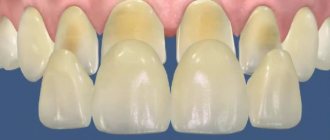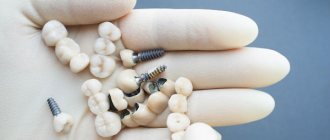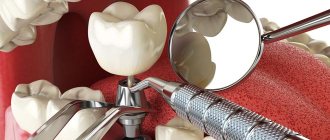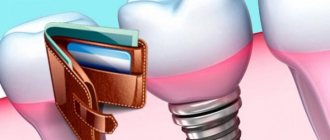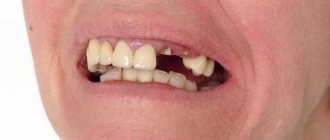Traditional methods of prosthetics require grinding of tooth enamel to ensure proper fit of the crown. This procedure has many disadvantages - when restoring a lost tooth, others have to be injured.
In addition, their depulpation will be a mandatory measure, and this leads to gradual destruction. Grinding teeth increases the risk of their rapid destruction due to disruption of tissue nutrition.
This type of prosthetics eliminates the possibility of replacing the prosthesis with a more modern one without further damaging the enamel.
A modern option would be dental prosthetics without grinding the enamel. There are several options for such restoration, including implantation. Each method has its own advantages and disadvantages, indications and contraindications.
Indications for the procedure
Installation of a structure without grinding is a desirable and uncontested option, which soon promises to become the main one in orthopedic dentistry.
Dental prosthetics without turning adjacent crowns is considered for the following indications:
- recovery in childhood;
- increased sensitivity;
- pronounced mobility of the crowns;
- large interdental spaces;
- contraindications for preparation.
The prosthetic procedure without the need for turning can be carried out in each case when the prosthetic option allows it. This method is more gentle and safer for oral health, so it is used at every opportunity.
Price
The cost of prosthetics using CBW technology is several times lower than other methods of dental restoration . This is due to minimal material costs and ease of installation.
The only thing that can significantly affect the price of this service is the choice of material for the crown. On average in Russia, installing a fixed prosthesis with a CBW system and a metal-ceramic crown will cost 20,000 rubles.
Until now, many dentists are of the opinion that this type of prosthetics is best used as a temporary installation of crowns. But according to reviews, the CBW system, in its properties and characteristics, is in no way inferior to traditional prosthetic methods .
If you find an error, please select a piece of text and press Ctrl+Enter.
Tags CBW dental crowns dentures crowns dental bridges fixed dentures
Did you like the article? stay tuned
Previous article
How to use denture spacers correctly?
Next article
Methods for diagnosing and treating cementum (root) caries
Types of prosthetics without grinding
Without grinding the enamel, the following methods of dental prosthetics are possible:
- implantation;
- adhesive bridges;
- on micro-locks;
- nylon;
- with hooks;
- tabs;
- Dante's method;
- CBW method;
- composites;
- cable-stayed method.
A long-term option would be implantation. Removable dental structures are used for temporary restoration. Other methods of prosthetics are considered according to indications, and in some cases they will be the only method of restoration when implantation is contraindicated or the patient does not want to have implants.
Dental implantation
Gentle, durable and reliable options are dental implantation and implant prosthetics (“all on four”). This may require bone augmentation. When its thickness is normal, the implant is implanted.
After its healing, a crown is placed. With the help of implants, it is possible to replace several or one tooth without grinding the adjacent ones.
The main advantages will be long-term use, right up to the end of life, no injury to adjacent crowns, and stopping the atrophic processes of the periodontal ligament. Disadvantages include a large list of contraindications and the risk of rejection.
The “all on 4” method allows for prosthetics to last a lifetime. 4 or 6 implants are implanted into the jaw, on which the structure is then secured.
Adhesive bridges
Adhesive bridge prosthetics began to be used relatively recently. It involves fixation on a special reinforced tape. It is attached to supporting crowns, on which small incisions are made without damaging the dentin.
After laying the tape in the recess, polymerization, modeling of the structure and its fastening are carried out.
Advantages of an adhesive prosthesis:
- cheapness;
- high strength;
- possibility of replacement;
- hypoallergenic.
A serious drawback is the short service life (1-2 years). After a certain time it will have to be replaced.
Prosthetics with micro-locks
Prosthetics of one tooth without turning adjacent teeth is possible by fastening with micro-locks. It is based on the use of a single crown or bridge structure. They are attached using microscopic locks, which have 2 parts.
One is placed inside the crowns of the prosthesis, the other is placed inside the supporting healthy teeth. This approach makes it possible to securely fixate with minimal tissue trauma, because the locks block access to the mucous membrane.
Removable nylon dentures
Flexible structures can be placed in the absence of several adjacent crowns without grinding the teeth. This material is lightweight, does not break and fits tightly. The base of the prosthesis is made from nylon, on which the crowns are placed.
The nylon prosthesis is fixed by suction to the palate and gums, so turning is not required.
Advantages of the technique:
- hypoallergenic;
- strength;
- quick addiction;
- slow wear;
- easy care;
- absence of a surgical stage.
Flaws:
- high price;
- need for correction;
- service life several years (up to 3);
- rubbing of periodontal tissues.
They are more often used as a temporary measure before installing a permanent system.
Removable dentures with hooks
Fastening the removable structure on hooks (clasps) without grinding the teeth is more reliable. This option of dentures is used in the absence of one or more crowns. More often, clasp dentures are fixed on hooks.
A prosthesis with hooks has many disadvantages, including rubbing of the gums by the clasps and poor aesthetics.
The hooks are visible in the mouth when talking and smiling.
Advantages:
- high structural strength;
- no need to grind adjacent crowns;
- reliable fixation and comfort for the patient, because there is no fear of the prosthesis falling out.
Cable prosthetics
Cable prosthetics, to describe it in a simplified way, is tying crowns with fiberglass thread. In this case, the enamel still needs to be ground down a little, but not significantly, and the dentin does not suffer from this. Recesses are made to accommodate threads, which are then covered with composite materials.
The advantages will be the absence of severe trauma to the enamel, preservation of the nerve and normal mobility of the crowns. Disadvantages - the appearance deteriorates over time, the material fades and absorbs dyes.
Using Tabs
Inlays are microprostheses, used when there is a large defect in a part of the tooth that cannot be restored with filling materials. They “complete” damaged crowns and fix them onto neighboring ones. This allows aesthetics and function to be restored.
Made from composite materials and ceramics.
Prosthetics using the CBW method
The CBW system is the prosthetic treatment of 1-2 teeth by creating microscopic channels in the supporting crowns in which almost the entire prosthesis is attached. Then a micro-lock is fixed in them, on which the structure is secured. As a result, the load falls on all supporting elements of the system.
Advantages:
- preservation of supporting teeth;
- lack of pressure on the periodontium;
- reversibility of prosthetics.
Contraindications will be severe destruction of the supporting crowns, thinning of tissues, and the absence of 2 or more teeth in a row. This method of prosthetics involves the use of ceramics, acrylic and metals.
Dante's method
Dante's technique does not require turning and involves the following manipulations:
- Laser cleaning to restore hard tissues;
- Perforation using aluminum oxide;
- Attaching the prosthesis support to the carbon fibers formed in the cavity;
- Polymer lining to give the prosthesis a natural look.
Composite dentures
Composite crowns are created without turning - this is an intermediate option between metal-ceramics and metal-free ceramics in terms of cost and quality. It consists of a frame and a covering.
The base is made of hypoallergenic material, then covered with a composite that is similar in color to natural fabrics. Installation of a crown is suitable for those with an allergy to metal, when high aesthetics is needed, but also a moderate cost.
Bridge without turning
To install a bridge without turning, you need to make small notches on the supporting crowns, which are required to fix the clasps. This method of fastening allows you to withstand a large load with its even distribution on the jaw.
Some dentists question the reliability of such restoration and recommend installing a bridge only as a temporary prosthesis for dental implantation before making a permanent one.
Prosthetics with flexible nylon prostheses
If in the two previous methods it was possible to restore only one tooth, then the use of nylon dentures allows you to recreate several consecutive teeth, and in some cases, the entire dentition of the upper or lower jaws. This manufacturing option is comparable to conditionally removable or even complete removable prosthetics.
Flexible nylon prosthesis
Nylon is light, thin and extremely flexible. It is used in construction as a frame (base) on which one or more artificial teeth are attached. It is due to the special properties of nylon that the prosthesis tightly grips the gums and supporting teeth, while at the same time very softly adhering to one of the palates.
Manufacturing:
- As usual, silicone impressions are first made of the problem area of the oral cavity and the surrounding mucous membrane.
- Then, using a special apparatus, the frame of the future prosthesis is cast over them under very high pressure.
- The required number of dental crowns are attached to the resulting base.
Advantages of the method:
- Allows you not to feel the prosthesis in your mouth. The old type of removable dentures put pressure on the gums, so most patients treated them very poorly. But nylon structures are not felt in the mouth after about a week of using them.
- An allergic reaction is excluded, because the prosthesis does not contain any metal ions, but monomers.
- The structure is securely and firmly attached. If it is a complete removable denture, then it is attached without the use of additional adhesive materials; if it is partially removable, then nylon clasps are used for fixation, which are secured to the supporting teeth.
- Nylon does not absorb other substances, including dyes, and remains translucent throughout its service life.
- Dentures do not require special care.
Disadvantages of the method:
- The pattern of the mucous membrane of a person’s mouth changes over time, and the prosthesis in areas of contact with it will begin to rub the tissue of the mucous membrane. In this case, adjustments to the entire structure are required.
- They wear out quite quickly. Their service life is two to three years.
- High price. The price of such a prosthesis is approximately twice as high as the cost of a rigid plate prosthesis made of acrylic.
Prosthetics of anterior and chewing teeth without turning
To replace a defect in the anterior group of teeth, microprostheses can be used:
- crowns;
- tabs;
- veneers;
- Lumineers
To restore chewing teeth - bridges, clasps, adhesives and other durable structures. In each case, it is possible to replace the defect without the need for turning.
The best option to restore the aesthetics of incisors would be to use ultra-thin lumineers, the installation of which does not require grinding down the enamel. They are fixed with special glue.
Microprosthetics is used to restore the frontal group with aesthetic defects:
- darkening;
- chip;
- wide interdental space.
Bridge without turning
Prosthetics with micro-locks is a relatively new type of restoration of a lost tooth. The method is quite simple: microchannels are created in the walls of the supporting teeth, in which locks are fixed that hold the intermediate part of the bridge. The supporting teeth are not ground down or depulped (nerves are not removed). Due to the design features, bridges with micro-locks can withstand loads that far exceed the maximum possible value of chewing pressure, and the locks optimally distribute the load between the supports, eliminating pressure on the gums. However, the reliability of the system is quite questionable, and is recommended by leading dentists as a temporary structure, for example, during the healing period of an installed implant in the smile area.
Stages of the procedure
Prosthetics of teeth without turning adjacent teeth is a technology that requires compliance with a number of conditions. The supporting crowns must be healthy, otherwise they will have to be depulped.
Before making impressions of an artificial tooth, professional oral hygiene and sanitation are performed in order to exclude foci of infection and inflammation.
What stages does defect replacement without turning include:
- Clinical:
- examination of the oral cavity;
- professional hygiene;
- rehabilitation;
- treatment of jaw pathologies;
- selection of a suitable recovery option;
- taking impressions;
- fitting of a prosthesis;
- final fixation in the oral cavity.
- Laboratory:
- making a base,
- artificial tooth is attached
- if necessary, correction is carried out.
How is the procedure done?
To install prostheses in this way, there is a certain algorithm of actions that eliminates the risk of doctor error and the occurrence of further complications .
CBW prosthetics takes place in two stages. At the first stage, the following manipulations are performed:
- An X-ray examination is performed before the procedure ;
- then, the dentist takes impressions of both jaws and selects the shade of the future crown;
- Before preparing the canal, it is necessary to perform parallel alignment of the supporting crowns and positioning of the locks. To do this, the doctor, using a regular bur, processes the proximal surfaces of the adjacent teeth and determines the position of future supports ;
- Using a special angled bur for CBW systems, microchannels are drilled on the proximal surfaces of both teeth. The channels are located parallel to each other at a distance from the gum not exceeding 1 mm;
- the channels are treated with sodium hypochlorite and phosphoric acid , after which they are washed with water and dried,
- Next, a small amount of cement is introduced into the canal using a brush ;
- Micro-locks, pre-treated with an adhesion-increasing agent, are installed in the prepared channels . For this purpose, bonding or dental primer is most often used. The locks are fixed with the conical side to the occlusal surface;
- After installation, the dentist removes excess cement using a scaler and takes impressions to make a crown . If necessary, temporary crowns can be fixed.
Read about the features of prosthetics on implants in the absence of teeth in a separate publication.
In this article we will tell you whether it is possible to repair dentures at home.
At the link https://www.vash-dentist.ru/protezirovanie/semnyie-p/byugelnyie/nizhnyuyu-chelyust-foto-raznovidnosti-primeryi-tsen.html you will find patient reviews about the experience of using a clasp denture on the lower jaw.
The second stage consists of installing the crowns on the fixed supports and takes a minimum of time, since this requires only a few steps:
- the dentist selects the most suitable fixation agent , after which he applies a rubber dam to the working area;
- then treats the bridge and supports with an adhesive agent and thoroughly dries them;
- applies cement to clasps and dentures;
- after which it installs it, excluding pressure, and carries out polymerization ;
- Finally, the doctor removes the remaining cementitious substance with a probe and checks the occlusion.
Watch the video for the sequence of the procedure:
Prices for dental prosthetics without turning
The cost is determined depending on the type of structure, preparatory procedures, type of fastening and pricing policy of the selected clinic.
- Installation of the structure without turning will cost 15,000 - 45,000 rubles.
- Using the CBW system - from 35,000 rubles.
- An adhesive bridge structure will cost 6,000-10,000 rubles, an acrylic one - from 7,000 rubles, a composite crown - up to 10,000 rubles.
- A nylon removable denture without turning will cost more - from 30,000 rubles.
What is the system?
The CBW system is a fairly new prosthetic technique, but it is based on many years of clinical experience in this field, and therefore is of high quality. This method allows you to eliminate defects in the dentition without damaging adjacent crowns.
With the help of CBW, it is possible to restore included defects with the absence of 1 or 2 teeth. To do this, miniature locks up to 1.8 mm long and up to 1.2 mm wide are installed in the adjacent teeth, acting as supports. These locks are used to secure the artificial crown.
In this case, the load is evenly distributed between the load-bearing supports. A distinctive feature of this system is that the denture can withstand a load exceeding the chewing pressure by 3 times .
Advantages and disadvantages
The only disadvantage of prosthetics without turning is the impossibility of installing any structure. Some options require mandatory preparation of the supporting teeth.
The advantages of installing a structure without turning will be:
- reduction of pain;
- maintaining the integrity of the crown;
- no need for depulpation;
- extending the service life of support units;
- the ability to replace the design with a different type;
- extending the life of the prosthesis;
- reduction of preparation time.
How is it different from similar methods?
CBW prosthetics compares favorably with similar systems for eliminating included dentition defects.
The advantages of this method in relation to the most popular orthopedic concepts are summarized in this table:
| Similar methods of dental restoration | Benefits of CBW |
| Traditional dentures | — minimum crown preparation. To install the structure, you only need to form a small channel, the length of which does not exceed 2 mm; — the risk of pulp injury and nerve damage is reduced to zero; — any impact on gum tissue is excluded. |
| On tabs | — the installation of this design is completely reversible. When removed, the crowns remain intact; — the cost of the service is significantly lower than prosthetics with inlays; - there is no pressure on surrounding tissues. |
| On implants | — the procedure does not involve surgical intervention; — after fixation, no time is required for engraftment; - has a minimum of contraindications; — can be used to restore teeth located in the maxillary sinus area; — the minimum permissible distance between adjacent crowns is 7 mm. |
| Adhesive | — the degree of resistance to mechanical stress is several times greater; — provides the necessary retention of the prosthesis; — distributes the load as evenly as possible; — eliminates fit problems. |
The CBW system is distinguished by its favorable price, quick installation and optimal aesthetic results. Also, this prosthetics can be performed on teeth that have undergone filling.
Dental implantation
The most expensive, but also the most aesthetic method is dental implantation. Before starting implantation, it is necessary to remove the remains of the old tooth and wait for the gum to heal. Sometimes additional bone tissue growth is required.
Implantation involves 4 main stages.
- An incision is made on the gum surface, forming a recess for installing an implant.
- Installation of the gum former in the recess, on which soft tissue will begin to grow in the future.
- After the gums have healed, the former is removed and a titanium pin is placed in the hole.
- A permanent dental crown is installed.
The central advantage of implantation is the long-term operation of implants and the prevention of bone tissue atrophy.
